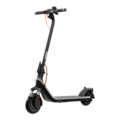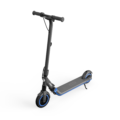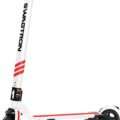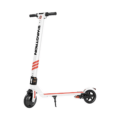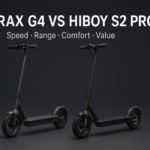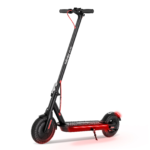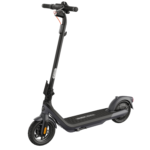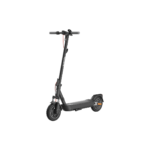- Home
- Scooters
- Electric Scooters
- Segway Ninebot F2
Segway Ninebot F2



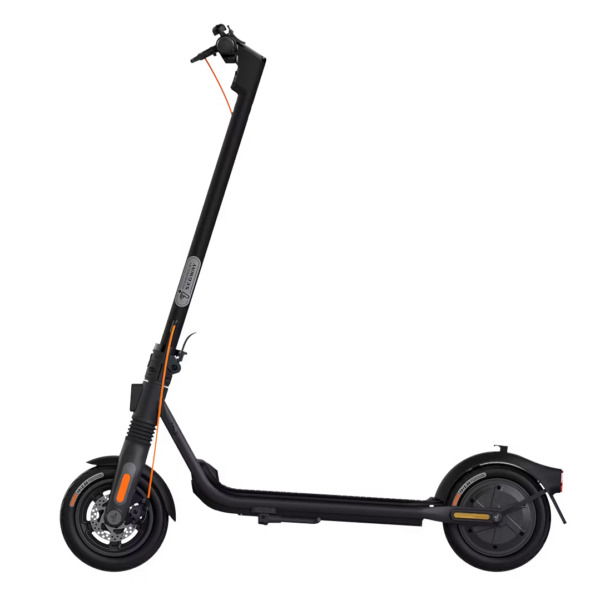
- Battery Range: 40 km / 25 mi
- Top Speed: 30 km/h (18 mph)
- Motor Power: 350 W nominal
- Weight Capacity: 120 kg (265 lb)
- Charging Time: ~6.5 h
- Scooter Weight & Portability: 17.2 kg (approx. 37.9 lb)
PROS
- Integrated turn indicators, TCS, and Apple Find My support
- Self-sealing 10″ tyres (wide, puncture-resistant jelly layer)
- Manageable 17.2 kg weight with quick fold
- Predictable dual-brake setup (disc + E-ABS)
- Solid app ecosystem; clear dashboard
CONS
- No suspension on the base F2
- Real-world range trails MAX-class scooters
- Cruise control varies by region/firmware (not always available)
- Hill climbs are fine to ~18%, but steeper/longer grades slow it down

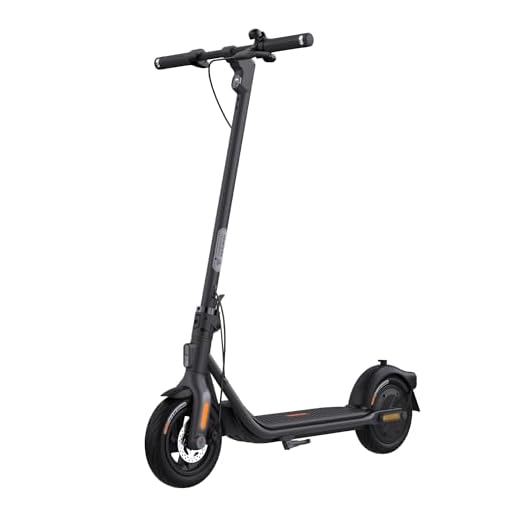
A modern commuter that favors clarity over complexity
The Segway Ninebot F2 aims to make city rides simple. It skips heavy suspension and high-strung power, focusing instead on stability, visibility, and low upkeep. As a result, it accelerates smoothly, tracks straight at bike-lane speeds, and folds fast when you reach the door. Moreover, it adds turn indicators, traction control, and app tools without turning setup into homework.
Who the F2 is really for
This scooter suits daily riders who cover short to medium distances on mostly decent asphalt. Campus commuters, office workers with mixed errands, and first-time buyers will feel at home. It’s quick enough to flow with traffic, yet calm enough for crowded paths. Because the chassis is lighter than MAX-class models, stairs and trains feel manageable. If you value visibility and clear communication in traffic, the integrated indicators and strong lighting make a daily difference.
Design philosophy: practical, not precious
The F2 chooses simplicity on purpose. No suspension means less weight, fewer creaks, and fewer parts to maintain. Comfort instead comes from tyre volume, smart geometry, and a cockpit tuned for steady steering. The fold is clean and positive, so the scooter moves from street to hallway without drama. Routine checks stay short: tyre pressure, brake cable tension, and latch hardware. These quick touchpoints keep the ride feeling tight for seasons, not weeks.
Motor character and throttle feel
Character matters more than raw numbers. The rear hub builds speed progressively, which is ideal around pedestrians and parked cars. Eco, Drive, and Sport modes let you bias efficiency or punch with a tap. Because the motor drives the rear wheel, weight transfer under throttle adds grip where you need it. Hill starts feel controlled; the scooter won’t leap or bog. In daily use, you get confident thrust you can modulate with one thumb.
Speed in the real world
Bike-lane flow often sits between 20–25 km/h. That’s exactly where the F2 feels settled and predictable. North American units may allow a bit more headroom; EU versions respect local limits. Either way, the chassis tracks straight and resists the nervous twitch of short wheelbases. Side gusts and imperfect tarmac don’t unsettle it. Therefore, your hands stay relaxed and your line stays clean, which reduces fatigue on longer rides.
Battery sizing that respects daily life
The pack targets practical distance instead of marathon range. Consequently, you can commute, add a lunch detour, and still have room for errands. Gentle riders stretch farther; brisk riders trade a little distance for pace. If you regularly exceed 25–30 kilometers per day, consider the F2 Plus. Otherwise, the base F2’s capacity hits a daily sweet spot. Another benefit of a moderate pack is predictable turnaround time at the outlet.
Charging habits that extend lifespan
Lithium cells love moderation. Opportunistic top-ups, reasonable temperatures, and avoiding deep discharges all help. A quick plug-in while answering email adds meaningful kilometers without stressing the pack. During workweeks, keeping charge between roughly 30–80% supports longevity. Save 100% top-offs for longer weekend rides or cold snaps. These habits sound fussy at first, yet they become second nature within a week.
Ride comfort without suspension
No suspension doesn’t equal no comfort. The F2 relies on 10-inch, wider-than-typical tyres for air volume and bump absorption. Correct pressures let the scooter skim over seams and faded asphalt. The deck is long enough for a relaxed, staggered stance, which eases knees and hips. Calm steering lets your arms stay loose, further smoothing the ride. Square-edged potholes still thump, but everyday pavement feels friendly for the class.
Handling, turning, and lane positioning
The F2 rewards smooth inputs. Look through corners, roll on gently, and it carves tidy arcs without mid-turn corrections. Handlebar sweep and height place your shoulders comfortably above the steering axis, which helps quick S-bends on shared paths. Rear-drive traction improves exits from slow corners. Because deck height is sensible, the scooter never feels tippy while shoulder-checking or signaling.
Braking you don’t have to baby
Stopping confidence comes from a balanced system. A mechanical front disc offers linear bite, while rear electronic regen adds steady drag and recovers a bit of energy. On dry days, the disc does the heavy lifting; on wet mornings, regen smooths deceleration as the disc maintains grip. Cable checks are simple, pad wear is gradual, and lever feel stays consistent. Practice a few hard stops in a quiet lot, and you’ll build muscle memory fast.
Lighting, indicators, and visibility
Being seen is as important as seeing. The headlight is bright, the tail/brake light is responsive, and side reflectors boost cross-traffic visibility. Integrated turn indicators broadcast intent at both ends, which reduces ambiguity at night. Buttons sit where your thumb expects them, so you don’t hunt mid-turn. Add a reflective strap if you ride in heavy dusk traffic, and drivers will notice you sooner.
Smart features that genuinely help
Useful tech beats flashy gimmicks. The app handles pairing, ride modes, cruise settings, firmware updates, and a motor lock. Traction Control (TCS) refines rear-wheel behavior on wet leaves, painted lines, and loose grit. Optional Apple Find My integration brings real tracking when you can’t remember where you parked. None of this demands tinkering each ride; you set it once and benefit daily.
Anti-theft is a system, not a switch
Security works in layers. The app lock immobilizes the motor and can chirp on movement. Find My adds location awareness. A quality U-lock prevents easy grabs. Visible, camera-covered parking discourages opportunists. Because the F2 folds quickly, you can bring it indoors more often, which quietly raises security without adding gadgets.
Portability and the fold-carry routine
Daily riders fold more than they expect. The F2’s latch closes positively and opens just as easily at the curb. The folded footprint slides under desks or beside café tables. When carried, weight sits close to your body, so your wrist suffers less than with front-heavy designs. On trains, you can stand it vertically and tuck it against your legs. Tidy riders finish commutes calmer.
Build quality and durability over seasons
Durability shows up as the absence of drama: no rattles, minimal stem play, and a deck mat that still grips in wet shoes. The F2’s structure doesn’t chase grams for spec sheets, so it stays composed after months of knocks. Hardware resists micro-loosening, though periodic checks are still smart. Tubeless, self-sealing tyres shrug off tiny punctures that would otherwise derail mornings.
Weather readiness and water etiquette
Cities don’t pause for drizzle. The F2’s water resistance helps, but judgment still rules. Slow earlier on slick surfaces, avoid aggressive lean on paint, and leave extra room. Wipe the scooter dry after soaking rides and store it warm enough to evaporate moisture. Expect winter range dips; plan with an earlier charge. As temperatures swing, watch tyre pressure—just a few PSI changes comfort and grip.
Maintenance that respects your time
Ownership should be quick and predictable. Check tyre pressures weekly with a reliable gauge. Spin each wheel to listen for rub. Squeeze the brake lever to confirm consistent travel. Inspect the fold hardware monthly and snug to spec if needed. Clean the deck after wet rides and scan tread for embedded debris. Update firmware when stable releases drop. These steps take minutes and prevent bigger headaches.
Common accessories and useful upgrades
Some add-ons earn their keep. A compact pump with a gauge preserves tyres and range. A bright, quick-release headlight improves night vision without wiring hassles. A small bell or electronic horn helps on shared paths. In wet seasons, a fender extender keeps spray off shins. A phone mount can aid navigation, but voice prompts keep eyes up. Because indicators are built in, cockpit clutter stays low.
Comparisons that help decisions
Compared with ultra-light starters, the F2 rides calmer, stops better, and lasts longer on a charge. Against suspended hybrids, it’s lighter and simpler, though less plush. Versus MAX-class scooters, it gives up absolute range but adds indicators, TCS, and easier portability. Therefore, match the scooter to your real route: distance, stairs, storage, and road quality matter more than any single spec.
Ideal riders, routes, and seasons
The F2 adapts across seasons. Spring and fall bring easy range and grip. Summer headwinds nudge you toward Drive mode. Winter cold suggests earlier charges and gentler speeds. Heavier riders still find the chassis planted; lighter riders enjoy predictable steering. Students and office commuters can stash it easily, while weekend riders can loop parks without anxiety.
Value that appears after the honeymoon
True value emerges over months. Wider self-sealing tyres reduce flats. Simple brakes demand fewer tweaks. App-level security and Find My reduce worry. The quick fold saves time at both ends of the day. Because it isn’t chasing extremes, the F2 stays satisfying long after the novelty fades. It does the job, daily, with minimal fuss.
Where the F2 isn’t the right tool
If you climb long, steep grades, you’ll want more sustained power. If your streets are broken, you’ll want active suspension. If you sprint above bike-lane pace for fun, you’ll want a sport-tuned machine. The F2 can dabble, but it won’t replace a hill specialist, plush hybrid, or hot-rod scooter. Knowing that clarifies its appeal as a commuter first.
A quick note on specs and naming
Spec sheets help, but your route decides. If you carry a heavy backpack, ride longer distances, or face rougher streets, the F2 Plus or F2 Pro pays off. If your loop is compact and storage tight, the base F2 nails the brief. Browsing rivals can illuminate trade-offs, yet hallway width, stair counts, and rail rules often matter more than a few watts or watt-hours.
Final verdict: the “just right” daily scooter
Strip commuting down to needs, and the F2 stands out. It starts cleanly, rides predictably, stops surely, and signals clearly. It folds fast and tucks away without demanding new furniture. It avoids chronic flats and fiddly adjustments. While it won’t win drag races or coast like a MAX-class pack, it wins something more important: consistency. Day after day, it simply works. For many riders, that’s exactly what a scooter should do.
Specifications
General
| Model The Model specifies the exact version or name of the scooter. It helps identify its unique design, features, and specifications within the manufacturer’s product line. Knowing the model makes it easier to compare options, find compatible accessories, or look up support information. | Ninebot F2 |
| Brand The Brand identifies the manufacturer or company that designs and produces the scooter. A trusted brand is a sign of quality, reliability, and good customer support. Well-known brands often have higher standards for safety, performance, and after-sales service, giving you more confidence in your purchase. | Segway |
| Release Date The Release Date indicates when the scooter model was officially launched on the market. This helps you know how current the design, technology, and features are. A newer release date often means updated components, improved performance, and the latest safety or smart features. | 01 January 2023 |
| Recommended Age Recommended Age indicates the minimum age range that the scooter is designed for, based on safety, size, and ease of use. Following the recommended age helps ensure that riders can handle the scooter’s speed, weight, and controls comfortably and safely. Always check local laws and use protective gear, especially for younger riders. | 16+ (region/retailer pages may show 14+ minimum) |
Performance & Power
| Motor Power (Wattage) What it means: The motor power, measured in watts (W), shows how strong the scooter’s electric motor is. Why it matters: Higher wattage usually means better acceleration, more torque, and improved performance on hills or rough terrain. For example, a 250W motor is good for flat city roads and light riders, while a 500W or 1000W motor provides more power for faster speeds or climbing steep inclines. | 350 W nominal, 700 W max |
| Top Speed The Top Speed indicates the maximum speed that the scooter can reach under optimal conditions. It’s usually measured on level ground with a fully charged battery and an average rider weight. A higher top speed allows you to travel longer distances faster, but always ensure you ride within legal speed limits and your personal comfort zone for safety. | 30 km/h (18 mph) NA; 25 km/h (EU-limited) |
| Battery Capacity Battery Capacity refers to the total amount of energy the scooter’s battery can store, usually measured in ampere-hours (Ah) or watt-hours (Wh). A higher battery capacity means you can ride longer distances on a single charge, reducing the need for frequent recharging. Keep in mind that actual range can vary depending on rider weight, terrain, speed, and weather conditions. | 367 Wh (36 V, 10.2 Ah) |
| Estimated Range per Charge The Estimated Range per Charge indicates the average distance the scooter can travel on a single full battery charge. This range is calculated under optimal conditions, such as flat terrain, moderate speed, and average rider weight. Real-world range may vary depending on riding style, terrain, weather, and load. A longer range means fewer recharges and greater freedom for longer trips. | 40 km / 25 mi theoretical; ~30–33 km at max speed (test method) |
| Hill Climb Ability Hill Climb Ability describes the maximum incline or slope that the scooter can handle while maintaining stable performance. It’s typically expressed as a percentage or in degrees. A higher hill climb rating means the scooter can tackle steeper hills without losing too much speed or power. Actual climbing performance may vary based on rider weight, battery charge, and terrain conditions. | up to 18% |
| Drive System The Drive System refers to how power from the motor is delivered to the wheels. Electric scooters typically use either a hub motor (directly integrated into the wheel) or a chain/belt drive system. A high-quality drive system ensures smooth acceleration, efficient power transfer, and low maintenance. The choice of drive system affects performance, noise level, and overall ride experience. | Rear-wheel hub motor (RWD) |
Charging & Electrical
| Charging Time Charging Time indicates how long it takes to fully recharge the scooter’s battery from empty to 100% using the standard charger provided. Faster charging means less downtime and more time on the road. Actual charging time may vary slightly depending on battery capacity, charger output, and environmental conditions. | ~6.5 h |
| Battery Type Battery Type refers to the specific technology used in the scooter’s battery, which affects performance, lifespan, weight, and charging time. Most modern electric scooters use high-quality lithium-ion (Li-ion) batteries because they offer a good balance of energy density, durability, and low maintenance. A reliable battery type ensures consistent power delivery and longer riding ranges. | Lithium-ion 36 V; Smart BMS protections |
| Removable Battery A Removable Battery means the battery pack can be easily detached from the scooter for convenient charging and replacement. This feature allows you to charge the battery separately, swap it with a spare for extended range, or securely store it indoors in extreme weather. Removable batteries add flexibility and make it easier to keep your scooter powered up wherever you are. | No |
| Regenerative Braking Regenerative Braking is an energy-saving feature that converts some of the energy normally lost during braking back into battery power. When you slow down or brake, the motor works in reverse to generate electricity, which helps extend the scooter’s range and improves overall efficiency. This system also reduces wear on traditional brake components, leading to lower maintenance over time. | Yes |
| Lighting Lighting refers to the built-in front and rear lights that enhance visibility and safety when riding in low-light conditions or at night. Good lighting helps you see the road ahead and ensures that other road users can see you. Many scooters include LED headlights, taillights, and sometimes brake lights or side reflectors for added safety and compliance with local traffic regulations. | Front LED headlight, rear/brake light, integrated turn indicators (E-Mark on EU variants) |
Build & Dimensions
| Scooter Weight Scooter Weight refers to the total weight of the scooter when fully assembled, including the battery. This affects how easy it is to carry, lift, and store the scooter when not in use. A lighter scooter is more portable and convenient for commuting, especially if you need to carry it upstairs or onto public transport. Keep in mind that a sturdy frame and quality components may add to the weight but also contribute to better durability and ride stability. | 17.2 kg (approx. 37.9 lb) |
| Maximum Rider Weight Maximum Rider Weight indicates the highest rider weight that the scooter is designed to safely support while maintaining optimal performance and stability. Staying within this limit helps ensure reliable acceleration, braking, and climbing ability, and it protects the frame, suspension, and motor from excessive strain. Exceeding the recommended limit may reduce performance and increase wear on components. | 120 kg (265 lb) |
| Deck Size Deck Size refers to the dimensions of the scooter’s standing platform. A wider and longer deck provides more foot space, allowing you to stand comfortably and adjust your stance while riding. A well-sized deck improves balance and stability, especially on longer rides or at higher speeds. Compact decks, on the other hand, help keep the scooter lightweight and portable. | ~490 × 160 mm usable (rider-measured) |
| Handlebar Height Handlebar Height refers to the distance from the deck to the handlebars, which affects your riding posture and comfort. An appropriate handlebar height helps you maintain good balance, reduces strain on your back and arms, and makes steering more comfortable. Some scooters have adjustable handlebars to fit riders of different heights, while others have a fixed height for a streamlined design. | 1214 mm (overall height, unfolded) |
| Folding Mechanism The Folding Mechanism describes how easily and securely the scooter can be folded for carrying and storage. A well-designed folding system lets you quickly collapse the scooter into a compact size, making it convenient to transport on public transit, store under a desk, or fit into a car trunk. Look for sturdy latches and safety locks to ensure the scooter stays firmly in place when folded or unfolded. | Yes |
| Dimensions Folded Dimensions indicate the size of the scooter when it’s fully folded. This measurement shows how much space the scooter will take up when stored or carried, making it easier to check if it will fit in your car trunk, under a desk, or in a closet. Compact folded dimensions are ideal for commuters who need to bring their scooter on public transport or store it in tight spaces. | 1143.5 × 570 × 484 mm |
| Material Material refers to the primary construction materials used for the scooter’s frame and key components. High-quality materials like aircraft-grade aluminum, reinforced steel, or durable composites provide strength, stability, and a lighter overall weight. A sturdy material ensures the scooter can handle daily wear and tear while maintaining safety and performance. | High-strength steel frame (series messaging) |
Safety & Control
| Brake Type(s) Brake Type(s) describe the braking systems the scooter uses to help you slow down or stop safely. Common brake types include mechanical brakes (like drum or disc brakes), electronic brakes, and foot brakes. Many scooters combine multiple braking systems for added safety and shorter stopping distances. The type and quality of brakes affect your control, especially when riding at higher speeds or on slopes. | Front disc + rear electronic regenerative (dual braking) |
| Suspension Suspension refers to the system that absorbs shocks and vibrations while riding, providing a smoother and more comfortable ride over uneven or rough surfaces. Scooters may have front suspension, rear suspension, or dual suspension for better shock absorption and stability. Good suspension helps reduce rider fatigue and improves control, especially when riding on bumpy roads or off-road paths. | None |
| Tire Type Tire Type refers to the kind of tires the scooter uses, which directly affects ride comfort, traction, and maintenance. Common types include solid (airless) tires, pneumatic (air-filled) tires, or hybrid options. Pneumatic tires offer better shock absorption and a smoother ride on rough surfaces, while solid tires are puncture-proof and require less upkeep. The right tire type helps ensure safe handling and a comfortable ride in different conditions. | Tubeless self-sealing pneumatic with jelly layer (≈58 mm width) |
| Tire Size Tire Size indicates the diameter and width of the scooter’s tires, which affect ride comfort, stability, and how well the scooter handles different terrains. Larger tires generally offer better shock absorption and a smoother ride over bumps and rough surfaces, while smaller tires keep the scooter lighter and more portable. Choosing the right tire size helps ensure a balance between agility and comfort. | 10-inch front & rear |
| Kickstand The Kickstand is a built-in stand that allows you to park your scooter upright when it’s not in use. A sturdy kickstand keeps the scooter stable and prevents it from tipping over, protecting it from scratches and damage. It also makes storing and accessing your scooter more convenient, whether you’re at home, work, or on the go. | Yes |
| Water Resistance Rating Water Resistance Rating indicates how well the scooter is protected against water and moisture, usually shown as an IP (Ingress Protection) rating. This rating helps you understand whether the scooter can handle light rain, splashes, or wet roads without damage. While most scooters are not fully waterproof, a good water resistance rating adds peace of mind when riding in changing weather conditions. Always avoid deep puddles or submerging the scooter to protect its electrical components. | IPX5 |
Features & Extras
| Display/Console The Display (or Console) shows important real-time information about your ride, helping you monitor your scooter’s status at a glance. Typical displays show speed, battery level, distance traveled, and riding mode. Some models also include additional features like Bluetooth connectivity, app integration, or backlighting for better visibility at night. A clear and easy-to-read display enhances safety and convenience on every trip. | Color LED dashboard: speed, battery, modes, BT, indicators |
| Ride Modes Ride Modes refer to the different speed and power settings you can choose to match your riding style or road conditions. Common modes include eco for maximum range and energy efficiency, standard for everyday balance, and sport or turbo for higher speed and stronger acceleration. Switching between ride modes allows you to customize performance, conserve battery, and ride safely in various environments. | Eco / Drive / Sport + Walk mode |
| Smart App Connectivity Smart App Connectivity lets you pair your scooter with a dedicated mobile app via Bluetooth. Using the app, you can monitor real-time ride stats like speed, battery level, and range, adjust settings such as ride modes or cruise control, lock the scooter for added security, and sometimes receive firmware updates. This feature adds convenience and allows you to personalize your riding experience right from your smartphone. | Segway–Ninebot App (lock, stats, firmware), Apple Find My tracking |
| Anti-Theft System The Anti-Theft System helps protect your scooter from unauthorized use or theft. This feature can include built-in alarms, electronic motor locks, GPS tracking, or remote locking through a mobile app. A good anti-theft system provides peace of mind when parking your scooter in public spaces, adding an extra layer of security to safeguard your investment. | App motor lock; Apple Find My location (when enabled) |
| Cruise Control Cruise Control allows you to maintain a steady speed without continuously holding the throttle. This feature makes longer rides more comfortable by reducing hand fatigue and providing a smoother, more relaxed riding experience — especially on flat, open roads or bike lanes. For safety, cruise control can usually be easily activated or deactivated while riding. | Yes |
| Accessories Included Accessories Included lists the additional items that come with the scooter to enhance your riding experience and convenience. Common accessories may include a charger, kickstand, bell, lights, phone holder, or carrying strap. These extras add value by making your scooter safer, easier to use, and ready to ride straight out of the box. | Power adapter/cable, toolkit & user materials (typical package) |
Warranty & Compliance
| Warranty Period The Warranty Period indicates how long the manufacturer guarantees the scooter against defects in materials and workmanship under normal use. A good warranty provides peace of mind, showing the brand’s confidence in its product quality. Always check what parts are covered, such as the frame, battery, and motor, and follow the maintenance guidelines to keep your warranty valid. | Typically 12–24 months depending on region/retailer (EU pages advertise 2-year core components testing/warranty messaging) |
| Certifications Certifications confirm that the scooter meets specific safety, quality, and environmental standards set by recognized organizations or regulatory bodies. Common certifications may include CE, RoHS, UL, or other local compliance marks, depending on your region. These certifications ensure that the scooter is manufactured to high standards and is safe and legal to use in your country. | UL 2272 compliance advertised for NA listings; E-Mark reflectors/indicators on EU units |
Price Comparison





